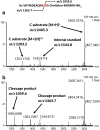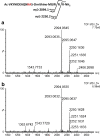Modification and validation of the Endopep-mass spectrometry method for botulinum neurotoxin detection in liver samples with application to samples collected during animal botulism outbreaks
- PMID: 33119784
- PMCID: PMC7806574
- DOI: 10.1007/s00216-020-03001-z
Modification and validation of the Endopep-mass spectrometry method for botulinum neurotoxin detection in liver samples with application to samples collected during animal botulism outbreaks
Abstract
Botulinum neurotoxins (BoNTs) are the most potent toxins known and they cause the paralytic disease botulism in humans and animals. In order to diagnose botulism, active BoNT must be detected in biological material. Endopep-MS is a sensitive and selective method for serum samples, based on antibody capture, enzymatic cleavage of target peptides, and detection of cleavage products using matrix-assisted laser desorption ionization-time-of-flight mass spectrometry (MALDI-TOF MS). In many cases of animal botulism, serum samples are not available or they do not contain detectable amounts of BoNT and liver sampling is an alternative for postmortem examinations. However, the Endopep-MS method is impaired by the inherent protease activity of liver samples. In the presented study, the Endopep-MS method has been successfully modified and validated for analysis of cattle, horse, and avian liver samples, introducing a combination of a salt washing step and a protease inhibitor cocktail. These modifications resulted in a substantial decrease in interfering signals and increase in BoNT-specific signals. This led to a substantial improvement in sensitivity for especially BoNT-C and C/D which are among the most prominent serotypes for animal botulism. Botulism was diagnosed with the new method in liver samples from dead cattle and birds from outbreaks in Sweden. Graphical Abstract.
Keywords: BoNT; Botulinum neurotoxin; Botulism; Endopep-MS; Liver; Protease inhibitor.
Conflict of interest statement
The authors declare that they have no conflicts of interest.
Figures







References
MeSH terms
Substances
LinkOut - more resources
Full Text Sources
Medical

